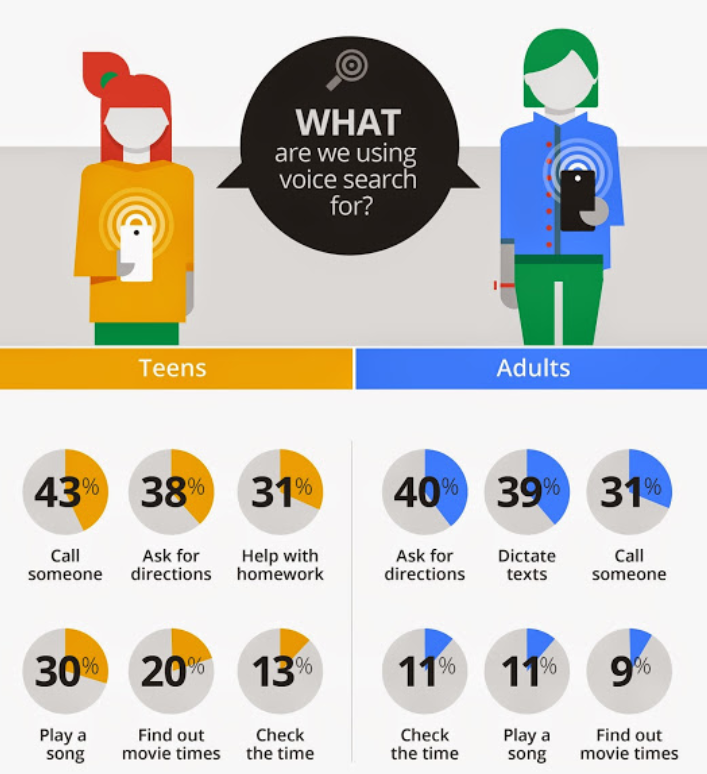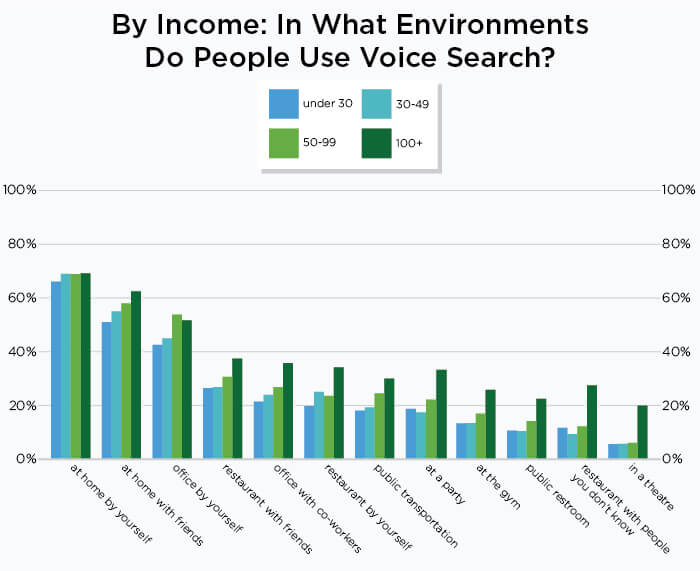Voice search and mobile usage are both on the rise and look set to shape the SEO industry for some time to come. Nonetheless, 62% of marketers have no specific plans for voice search in 2018.
How can marketers take action today to tap into two of the most important trends in the industry?
As mobile usage continues to grow, more and more users are comfortable with speaking to their devices rather than typing their queries.
Of equal importance are the advances in speech recognition technology that have allowed the likes of Google, Amazon, and Apple to offer a satisfying voice search experience.
There is plentiful context to make marketers aware of these emerging trends, with both mobile and voice search set to shape the future of the industry:
- Voice-enabled personal assistants are installed by default on all smartphones
- Google has revealed that more than 20% of searches on an Android device are voice searches
- The Amazon Alexa app recently topped the app store charts. The Google Home app occupied second position
- The Amazon Echo was once again the best-selling item on Amazon this holiday season
- Speech recognition accuracy is now north of 95% for all of the major technology providers
- Google’s mobile-first index is rolling out and will soon be applied to all sites
- comScore predicts that 50% of all searches will be by voice in 2020.
Though the two are not perfectly aligned, there is a clear correlation between the growth of voice search and the ongoing rise of mobile.
As the Internet of Things takes off, voice will be one of the most important unifying factors across all hardware. Whether at home, in the car, or at work, there will always be a voice-enabled device close to hand.
And yet, a recent study by BrightEdge reported that 62% of marketers are unlikely to implement a specific strategy for voice search over the next 12 months.
This is not due to a lack of awareness of the trend, but rather a lack of direction when it comes to preparing for its implications.
In a clear indication of how significant the shift to voice-based searches will be, Google recently released a new set of Search Quality Rating Guidelines for the Google Assistant.
Though specific to the Google Assistant, we can safely assume that the same rules and objectives underpin the functioning of other digital assistants too.
As such, this document can prove both illuminating and instructive as we look to move beyond the hype that voice search brings and arrive at some tips to direct our mobile SEO efforts.
The findings in Google’s official guidelines for voice search evaluation, along with the best practices we already have for mobile SEO, can help us create a hybrid set of tips to improve any site’s chances of ranking in this new landscape.
This begins with some technical considerations, then moves on to a more nuanced understanding of how consumers are using voice to interact with their devices. Finally, we must create the right content to fit our target contexts, and find a way to measure our progress.
Technical SEO for mobile devices
As with so many aspects of SEO, crawlability is the foundation upon which a mobile SEO strategy for voice search must be built.
Put simply, if a search engine cannot access and understand your content, your chances of appearing in search results are slim. This has always been important, but it takes on a new level of significance when viewed through the lens of voice search.
Often, voice search removes the traditional search engine results page (SERP) and instead aims to provide one answer in response to a query. This is a search engine’s first port of call; it is only when one answer cannot conclusively answer the query that a more traditional list of results will be displayed.
Fortunately, there are some guidelines we can follow to increase the likelihood of our content ranking via voice search:
- Schema markup: By adding schema markup, we can help to add structure to our website’s data. For example, we can alert search engines to elements that relate to events, prices, and people – among many others. When a search engine is trying to locate a response to a voice search, this extra information can prove invaluable.
- XML sitemaps: Having a clearly structure sitemap that can be navigated easily both by people and by search engines will increase the likelihood that your information can be sourced quickly in response to a query.
- Site structure: The structure of a website should mirror the journeys that users typically take when considering and making a purchase. For example, faceted navigation on an ecommerce site should aim to match common query strings.
- Carry out a mobile SEO audit: Before embarking on any of the more innovative aspects of voice search, conduct a full mobile SEO site audit to ensure that you are in a solid position.
- It is also worth reviewing the basics of mobile SEO to keep in mind the distinctions that set it apart from traditional SEO.
Understanding context
All language is contextual. The exact same query, at surface level, can in fact mean many different things based on how, when, where, and by whom it is said.
This is not a new discovery, but it is only recently that search engines have been able to understand the context of a query.
In part, this has been due to more sophisticated algorithms like Google’s Hummingbird update, which brought the concept of semantic search to life.
However, the biggest source of contextual information is the smartphone. Our phones are constantly sending and receiving data, all of which can be processed to comprehend our past, present, and even our future behaviors.
Now, when a user searches for a term like [canon cameras], a search engine can use smartphone data to understand the implied intent of the query:

This implicit intent, now known to a search engine, can help to shape and personalize the results that the user sees.
There are other effects of this deeper understanding.
Varied queries can ultimately express the same underlying intent. For example:

The expression of the response may differ, but all variations are ultimately answering the same question. The user wants to know what the weather will be like tomorrow.
This is helpful, as it allows us to see that we don’t need to answer every single possible query that is out there. Many guides on voice SEO suggest creating FAQ pages as a way to grow traffic, but this seems a stop-gap solution when we can do better. SEO needs to move away from creating “SEO pages” on websites that serve no real purpose other than to attract organic search clicks.
Thus far, our industry has focused mainly on what has been said by searchers. We pull a list of keywords with search volumes, difficulty scores and so on, and we map those to our pages. Where a page does not exist for a group of keywords, we create one.
A further level of nuance can be added by segmenting the keywords by purchase stage: informational, navigational or transactional, for example. These can also be categorized as ‘Know’, ‘Go’, and ‘Do’ moments.
That is useful, but it is overly simplistic. What we often end up with is a comforting illusion; a spreadsheet that smooths over the rough edges to provide a digestible view of what people search for, cell by cell.
Reality does not fit so readily into neat compartments.
In a presentation given last year, Tom Anthony of Distilled mapped out what the new ecosystem looks like, based on the huge amount of data a smartphone both sends and receives:

Even this is a reduction, but it does at least provide insight into the broader picture.
What this means is that when working on a mobile SEO strategy, we should identify the contexts in which our content could rank.
These contexts can be strung together to create a map of the typical user journey.
This can be informed by demographic data, as there are telling differences between the generations. In particular, we should note that younger generations are more comfortable with voice search and use it in very different situations to their older counterparts.

Stone Temple Consulting produced an excellent, in-depth study that goes further still to segment this data by income. In the chart below, all figures are in US Dollars:
 Source: Stone Temple Consulting
Source: Stone Temple Consulting
What we find through this report is that there are notable variations at every level of analysis. By location, gender, device, income level, and age, we find that people use voice search differently.
Marketers would do well to perform research of their own to pinpoint the right contexts for their business to target, through qualitative research and quantitative analysis.
Creating the right content at the right time
Once we have plotted out the potential contexts in which we could communicate with our audience, we need to create the content that will hopefully help us rank via voice search.
Though this is a nascent field, there are already some useful studies that can guide us in this process.
Voice queries tend to be longer, due to their closer relationship to natural speech patterns. This provides a significant amount of data for us to analyze, compared with the shorter queries we have grown accustomed to.
Where once he had to infer a consumer’s intent based on feedback signals (click-through rate, bounce rate, conversion rate), we can now start this process much earlier.
We should also bear in mind the anticipated input-output relationship between the consumer and the device. For example, a spoken query that prompts a spoken response will need to be fed by content that is clear, concise, and conclusive.
Google’s Research Blog offers the following areas for assessment when it comes to this kind of voice search:
- Information Satisfaction: the content of the answer should meet the information needs of the user.
- Length: when a displayed answer is too long, users can quickly scan it visually and locate the relevant information. For voice answers, that is not possible. It is much more important to ensure that we provide a helpful amount of information, hopefully not too much or too little. Some of our previous work is currently in use for identifying the most relevant fragments of answers.
- Formulation: it is much easier to understand a badly formulated written answer than an ungrammatical spoken answer, so more care has to be placed in ensuring grammatical correctness.
- Elocution: spoken answers must have proper pronunciation and prosody. Improvements in text-to-speech generation, such as WaveNet and Tacotron 2, are quickly reducing the gap with human performance.
This insight should flow directly into the site experience. If we know which task our consumer is trying to complete, we can make this process and seamless and as painless as possible.
There are some points that apply to any site aiming to create content for voice search:
- Remember that a voice search is only the start of the user journey. If your mobile site experience does not match the user’s intent, they will complete the journey elsewhere. Use a user-agent switcher or a site like http://mobiletest.me/ to see how your mobile experience matches up.
- Create content that responds to the most common conversational queries. Provide clear information that can easily be picked up by a search engine as it tries to provide one, true answer for each voice query. Tools like Answer the Public are useful for this task, but try to assimilate this information naturally into your content rather than creating a host of FAQ pages.
- Map this content to a logical site hierarchy that is crawlable for search engines and useful for consumers.
- Google is preparing to add voice queries to Search Console, so we will soon be able to assess and track our voice search performance.
Local SEO
Given that voice searches on a mobile device are frequently completed on the go, it should not be surprising that users often want help with navigation.
Interestingly, the growth in the number of ‘near me’ searches has slowed as people have come to expect Google to understand this implied intent.
Google uses its own Maps product to respond to these queries, so we can optimize our own Maps listings to help search engines and people to navigate better. There are a few tips to keep in mind when working on a voice search strategy for local SEO:
- Ensure that names, addresses and phone numbers are accurate across all locations.
- Consider using a specialist platform to manage your local listings and monitor your local search performance. There is a growing range of mobile SEO tools that can help with these tasks.
- Make it easy for consumers to act on their intentions. This means adding in clear calls to action and directions to further information.
What’s next for search?
It is important to understand Google’s vision for the future of search.
The technology has improved dramatically, but it is still some distance from fulfilling the ambitions of Google and Amazon. When this technology reaches its potential, there may be no need for a query at all, as the digital assistant will be able to pre-empt our actions.
For now, marketers need to assist the assistants in the manner outlined above.
In essence, technology is enabling behaviors that have their basis in pre-existing states of intent. The industry is growing in complexity, but simultaneously it is developing into a more realistic representation of how people want to search.
Through better understanding of both people and technology, marketers can create a voice search strategy that will stand the test of time.

